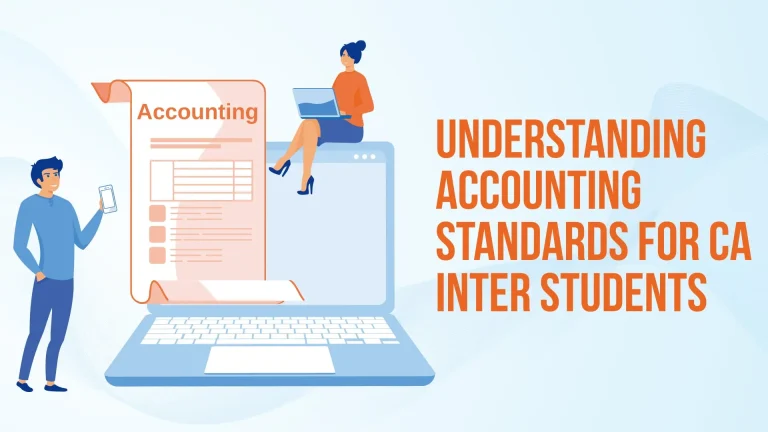Are you a student studying for the Chartered Accountancy (CA) Inter exam? If you’re looking to understand accounting standards better, you’re in the right place! Let’s dive into the world of accounting standards made just for CA Inter students. This guide will help you understand these standards thoroughly, giving you the tools you need to do well in your studies and in your future career. So, let’s get started on this journey together, exploring the ins and outs of accounting standards ca inter in a way that’s easy to understand and apply.
Introduction to Accounting Standards
Accounting standards are like the foundation of financial reports. They give a clear structure for companies to make and show their financial statements correctly and openly. These rules are super important because they make sure that financial reports are consistent, comparable, and trustworthy. This helps lots of different people, like investors, banks, and even government regulators, to make smart decisions based on the numbers they see.
Importance of Accounting Standards CA Inter Students
For CA Inter students, having a good grasp of accounting standards is really important. It’s like the foundation of their education, setting them up for their future jobs as chartered accountants. When students really understand accounting standards, it helps them a lot. They can understand financial reports better and know exactly what they mean. It’s like they have a clear map to guide them through all the complicated stuff in financial reporting. Understanding it well makes them feel more confident and skilled in their field.
Overview of Accounting Standards CA Inter Students
The CA Inter syllabus includes lots of accounting standards. Each one talks about different parts of financial reports. These standards cover many topics like recognizing revenue, dealing with leases, handling financial instruments, and putting together consolidated statements. Now, let’s look closer at some important accounting standards CA Inter students need to know. We’ll explain their rules and how they’re used in making financial reports.
Revenue Recognition (AS 9)
Revenue recognition is really important in accounting. It’s about figuring out when and how to count money earned from selling stuff or providing services. AS 9 tells us exactly when we should count revenue. It says it’s crucial to match the money earned with the costs we spent to earn that money. For CA Inter students, it’s super important to understand all the little details in AS 9. This helps them know how well a company is doing financially and make sure they’re following all the accounting rules. Understanding revenue recognition is like having a key to unlock the secrets of a company’s financial health.
Leases (Ind AS 116/AS 19)
Leasing is super common in business deals, and keeping track of leases means following certain rules. Ind AS 116 (which is just like AS 19) lays out how to deal with leases for both the people renting (lessees) and the ones renting out (lessors). It talks a lot about the difference between two main types of leases: finance leases and operating leases. CA Inter students really need to get comfy with these lease rules in Ind AS 116 to figure out how leases affect money stuff and to make sure they’re following all the accounting rules properly. Understanding these rules helps them know how leases impact finances and keeps them in line with accounting standards.
Financial Instruments (Ind AS 109/AS 30)
Financial instruments cover a wide range of stuff like cash, things people owe you (receivables), and more complicated things like bonds and derivatives. Ind AS 109 (like AS 30) tells us how to deal with these things in our accounts. It talks about how we should classify them, measure them (like figuring out their value), and decide when to include them in our accounts. For CA Inter students, it’s important to really understand this because it helps us see how a company is doing financially, especially when they’re dealing with lots of different financial stuff. And of course, it’s important to follow these rules to make sure our accounting is correct and follows the standards.
Consolidation (Ind AS 110/AS 21)
Consolidated financial statements give you the big picture of how a bunch of companies that are controlled by the same people or entity are doing financially. Ind AS 110 (which is like AS 21) explains how to make and show these statements. It talks a lot about how to combine the financial info from all the companies and what to do with the parts of the companies that aren’t fully owned by the controlling entity. For CA Inter students, understanding these rules is super important. They need to really get into the nitty-gritty of how to put together these statements so they can show the true financial situation of all the companies under one umbrella. It’s not just about adding numbers; it’s about following the rules to make sure everything is done correctly according to accounting standards.
For CA Inter students, understanding the intricacies of consolidated financial statements is essential. It’s not just about adding up numbers; it’s about following a set of detailed rules to ensure accuracy and compliance with accounting standards. Let’s break down some key concepts further:
- Combining Financial Information: When preparing consolidated financial statements, CA Inter students need to gather financial data from each company within the group. This includes information about assets, liabilities, revenues, and expenses. They must ensure that all relevant transactions between the companies are eliminated to avoid double counting and present a true and fair view of the group’s financial position and performance.
- Treatment of Non-Controlling Interests: Not all companies within the group may be fully owned by the controlling entity. Some may have minority shareholders, referred to as non-controlling interests (NCI). Ind AS 110 provides guidance on how to account for NCI in the consolidated financial statements. CA Inter students must understand the principles outlined in the standard to accurately reflect the NCI’s share of the group’s assets, liabilities, revenues, and expenses.
- Consolidation Process: The process of consolidation involves several steps, including identifying the entities to be consolidated, adjusting for intra-group transactions, and preparing consolidated financial statements. CA Inter students must navigate through these steps meticulously, ensuring that each aspect of the consolidation process is carried out in accordance with the accounting standards.
- Disclosure Requirements: In addition to preparing the consolidated financial statements, CA Inter students must also pay attention to the disclosure requirements outlined in Ind AS 110. These disclosures provide additional information about the nature and extent of the group’s activities, its ownership structure, and any significant transactions or events that may impact its financial position and performance.
IAS/IFRS Convergence
In recent times, there’s been a big worldwide shift towards following International Financial Reporting Standards (IFRS). This means that the way companies do their accounting is changing a lot. It’s important for CA Inter students to keep up with these changes because many countries are now using or adjusting their own accounting rules to match IFRS. This means students need to know not just the rules in their own country, but also how things are done according to IFRS. So, they’ve got to understand both their local accounting rules and the IFRS principles. This helps them stay on top of things and be ready for whatever changes might come their way.
Accounting for Business Combinations (Ind AS 103/AS 14)
Business combinations happen when one business merges with or buys another, which can make the accounting part pretty complicated. Ind AS 103 (similar to AS 14) explains how to deal with this in accounting. It covers stuff like figuring out what assets and debts the new business brings in, deciding on the value of the good stuff like reputation or brand name (called goodwill), and splitting up how much was paid for everything. For CA Inter students, it’s super important to understand all these details so they can show how these big deals affect the money stuff in the books of the company doing the buying. Understanding this helps them paint an accurate picture of how the company’s finances change after such deals.
Impairment of Assets (Ind AS 36/AS 28)
Assets owned by a company might lose their value because of changes in the economy or other reasons. This means the company needs to check if the assets are still worth what they paid for them. Ind AS 36 (which is similar to AS 28) tells us how to do this. It’s important for CA Inter students to get how this works. They need to know how to figure out if an asset is still worth what the company paid for it. This includes stuff like buildings and equipment, ideas or patents, and even the value of the company’s brand. If an asset is worth less than what the company paid, they have to show this in their financial reports. Understanding this process helps CA Inter students know how to handle it when assets lose value.
Accounting for Government Grants (Ind AS 20/AS 12)
Government grants are like gifts from the government to businesses, but they usually come with rules attached. Ind AS 20 (same as AS 12) tells us how to deal with these grants in our financial records. It’s important for CA Inter students to really understand this, so they can show in the books how these grants affect a company’s money situation and how well it’s doing. Let’s dive into the details of how we handle government grants in our accounting.
Elaboration:
When a government gives money to a business, it’s not just free cash – there are usually conditions or strings attached. These conditions could be things like how the money should be spent or what goals the business needs to achieve to keep the grant. Ind AS 20 (which is the same as AS 12) gives us a set of rules to follow when dealing with these government grants in our financial records. For CA Inter students, it’s crucial to really get a grip on this topic. They need to understand not just the basics but also the finer points of government grant accounting. This understanding helps them accurately show in a company’s financial statements how these grants impact its financial health and performance. It’s like solving a puzzle – you need to know where each piece fits to see the full picture. Understanding government grant accounting is like knowing where each piece goes in the financial puzzle.
Fair Value Measurement (Ind AS 113/AS 26)
Fair value measurement is all about figuring out how much things are worth right now. This means looking at assets (like what a company owns) and liabilities (like what a company owes) and finding out their current market value. Imagine it as the price you’d get if you sold something or the price you’d pay to get rid of a debt, in a fair and normal situation where buyers and sellers are both willing and informed.
Ind AS 113 (which is similar to AS 26) gives instructions on how to do this fair value measurement stuff and what information to share with others about it. For CA Inter students, it’s important to understand these instructions well. They need to know how to figure out the fair value of things a company owns or owes and then tell everyone about it in a clear way in the financial statements.
Understanding these principles from Ind AS 113 is crucial for CA Inter students. It helps them to correctly assess the value of assets and liabilities and to make sure that when they share this information in financial reports, it’s easy for everyone to understand what’s going on.
Future Trends and Developments in Accounting Standards
As businesses change, so do the rules for keeping track of their money. CA Inter students need to keep learning about these rules because they often get updated. It’s like staying up-to-date with the latest trends and tips in your favorite game or hobby. It’s important for them to keep their knowledge fresh because the way companies report their finances can change. Also, there are new technologies like AI and blockchain that are starting to change how financial reports are made. This means accountants may have to learn new skills to keep up with these changes. It’s like learning new tricks to play a game better. So, CA Inter students should be ready for these new challenges and opportunities. They can do this by staying curious and learning new things regularly.
A thorough grasp of accounting standards gives students the tools they need to handle tricky money deals, read financial reports correctly, and follow the rules. Keeping up with new trends and changes in accounting standards helps CA Inter students get ready for the fast-changing business world, where they can thrive and succeed.
Also Read:
- The ABCs of Account Accounting & Inventory System with GST ComplianceIn today’s fast-paced business world, keeping track of money and goods is crucial. That’s where an account accounting and inventory management system with GST compliance comes in. Let’s break down what it is, why it’s essential, and why using a… Read more: The ABCs of Account Accounting & Inventory System with GST Compliance
- Exploring Basics of Accounting TerminologyWelcome to the world of finance made simple! In this easy-to-follow guide, we’re breaking down the basics of accounting terminology. Whether you’re a business owner, a student, or just someone curious about money matters, we’re here to demystify the language… Read more: Exploring Basics of Accounting Terminology
- What is Online Accounting Software?Businesses are always looking for ways to make managing money easier. One tool that helps a lot is online accounting software. In this guide, we’ll talk all about it—what it is, what it does, and how it’s changing businesses, especially… Read more: What is Online Accounting Software?
- How to Prepare Final AccountsSetting out on the path towards final accounts offers an incredible glimpse into a company’s intricate financial story. Let’s examine key components that contribute to this tale while demystifying final account preparation complexities. Understanding Final Accounts: Final accounts are like… Read more: How to Prepare Final Accounts
Frequently Asked Questions
What are accounting standards?
Accounting standards are like rules that guide how companies prepare their financial statements. They make sure everyone follows the same practices, so it’s easier to understand and compare financial information.
Why are accounting standards important?
They’re important because they help people, like investors and lenders, trust a company’s financial reports. When everyone uses the same standards, it’s easier to see how well a company is doing.
What do CA Inter students need to know about accounting standards?
CA Inter students should learn about different accounting standards so they can understand financial reports accurately and follow the rules.
How do accounting standards benefit businesses?
They make businesses’ financial reports clear, consistent, and trustworthy, which helps them make better decisions and gain trust from investors and customers.
Which accounting standards are essential for CA Inter students?
Students should focus on standards like revenue recognition, leases, financial instruments, and consolidation to understand financial reports fully.
What is the role of IFRS in accounting standards?
IFRS is like a set of global rules for accounting. It helps countries around the world use similar standards, making it easier for businesses to operate internationally.
How do accounting standards evolve over time?
They change to keep up with new ways of doing business and to make sure the rules stay relevant and helpful for everyone involved.
What challenges do CA Inter students face with accounting standards?
Some concepts, like fair value measurement and impairment testing, can be tricky to understand, so students need to study hard and practice a lot.
How can CA Inter students stay updated on accounting standards?
They should keep an eye on updates from regulatory bodies, attend events, and keep learning to stay on top of any changes.
What career opportunities are available for CA Inter students proficient in accounting standards?
They can work in areas like auditing, financial analysis, and consulting, where knowing accounting standards well is crucial for success.








